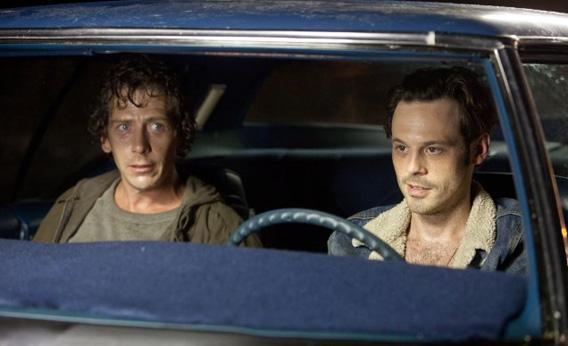The novels of George V. Higgins—a onetime Boston prosecuting attorney who had a long second career as a crime novelist—take place in a singularly unglamorous criminal subculture, a ragtag network of small-time crooks that’s too loosely structured to qualify as an “underworld.” Even by the standards of noir fiction, Higgins’ moral universe is a dingy and barren place, where every semicompetent hustler lives and dies alone and every human relationship is an undisguised transaction.
The Friends of Eddie Coyle, a 1973 film based on Higgins’ first published novel and directed by Peter Yates, offered a stark, unsparing portrait of the low-level gangster’s life as an insecure, low-paid, and perpetually perilous freelance job. Andrew Dominik’s new movie, Killing Them Softly, adapted by Dominik from Higgins’ third novel, Cogan’s Trade, tries to mine a similar vein of workaday fatalism, but the film is ultimately done in by Dominik’s bursts of directorial grandiosity (already in evidence in his overly fussy last film, The Assassination of Jesse James by the Coward Robert Ford). It’s hard to deglamorize the criminal life when you can’t resist showing a bullet leaving a gun barrel in stylized super-slow motion or scoring the anti-hero’s first entrance to a Johnny Cash song.
At least I think Brad Pitt, as the taciturn hitman Jackie Cogan, is meant to be the anti-hero of Killing Them Softly. It’s one of the movie’s structural weaknesses that we never really find a character on whom to hang either our sympathy or our antipathy. I’m all for movies that offer up a morally ambiguous, less-than-likeable cast of characters—The Friends of Eddie Coyle did exactly that, with a protagonist (played by Robert Mitchum) who could veer scene to scene from admirable to despicable to pitiable. But too many of Killing Them Softly’s half a dozen main characters come off as interchangeably nasty dullards who aren’t worth caring about enough to either love or hate.
Pitt’s Jackie doesn’t enter the film until a half-hour or so in; we spend the opening act in the company of Frankie (Scoot McNairy) and Russell (Ben Mendelsohn), a pair of inept hoods who are hired by Johnny “Squirrel” Amato (The Sopranos’ Vincent Curatola) to knock over an ongoing card game hosted by Markie Trattman (Ray Liotta). Squirrel’s plan—one that, he foolishly asserts, is foolproof—is to proceed on the assumption that Trattman will take the fall for the robbery, since he’s known to have arranged for an inside-job holdup of his own game in the past. The scene in which Russell and Frankie (barely) pull off the job is the movie’s best, a rare moment of raw, gritty suspense unaugmented by flashy directorial flourishes.
Soon after, though, things start to go south for the robbers, the robbed, and the audience all at once. Russell, a not-so-high-functioning heroin addict, brags about the card-game holdup to a fellow lowlife, and soon there’s a contract out on both his and Frankie’s lives. Trattman is, as predicted, widely assumed to be in on the heist, resulting in a menacing visit from ice-in-his-veins local boss Dillon (Sam Shepard). All the while, Dominik’s camera goes on an unpleasantly manic bender, zooming into and out of blackness to evoke the headrush of a heroin trip or slowing down to Matrix-level frame speed for a self-consciously luxurious bullet-in-the-head shot.
The scenes involving Russell have a tendency to wallow in the character’s abjection: He’s shown coated in a permanent donut glaze of junkie sweat, with frequent close-ups on his sketchy teeth. Similarly, when James Gandolfini shows up late in the game as a once-reliable hit man lost to depression and alcoholism—a character so miserable he makes you pray Tony Soprano did die in that last scene of the series—the camera lingers on his pasty, sagging face almost voyeuristically, treating him more as an object lesson (see what happens if you let the contract-killer life get to you?) than a character. Pitt and Gandolfini facing off as two temperamentally opposite assassins—one hypercontrolled, one impulsive and volatile—should have been the movie’s dramatic high point; instead, their two scenes together feel like setups for a confrontation that never happens. (The movie, which runs only 97 minutes, often seems edited down from a longer version; scene by scene, it drags, but several of the story arcs feel truncated.)
Killing Them Softly is about as subtle as a lead pipe to the shins. As Russell and Frankie shoot up the smack they’ve bought with their share of the holdup money, the soundtrack obediently serves up the Velvet Underground’s “Heroin.” But the film’s most misbegotten gambit may have been the decision to take Higgins’ heist-gone-wrong story out of 1970s Boston and relocate it in 2008 New Orleans, the better to profit from the symbolic windfall of both Hurricane Katrina and the financial crash. From the earliest frames, conversations about the price of contract killing and who’s dropping a dime on whom are conducted beneath campaign billboards for Obama and John McCain or over the drone of car-radio talking heads discussing the ethics of the financial bailout. (For a bunch of thugs, these guys listen to a good bit of political news.) In the movie’s facepalm-worthy final scene, a bar TV broadcasts Obama’s election-night speech as one character explicitly lays out for another all the ways in which the power plays among these money-grubbing gangsters are a metaphor for American capitalism itself. Dominik’s eagerness to make everything in his film stand for something larger causes the director to lose sight of the very quality that makes George V. Higgins’ books worth adapting in the first place: the ability to let his characters be nothing other than the venal, vulnerable, life-sized humans they are.
